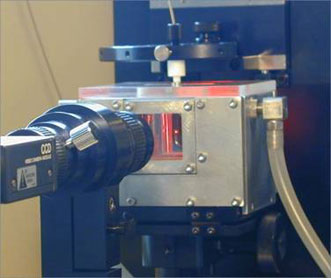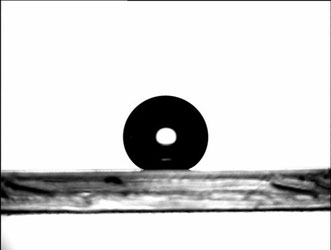| A tempering chamber
suitable for liquid / vapor, liquid
/ liquid, liquid / solid / vapor and
liquid / liquid / solid measurements
under controlled conditions. Temperature
is stabilized by a user-provided circulating
bath through a unique one-loop-three-sided
thermal transfer construction in the
aluminum chamber body, which allows
desired temperatures can be reached
and stabilized exceptionally fast.
The temperature range is from about
0 ℃ to about 120 ℃ if a suitable circulating
bath and fluid are used. Due to its
double-glass window construction,
problems with window condensation
can be effectively avoided, which
ensures a clear, crisp imaging quality
for measurements .
The chamber can be easily disassembled
for cleaning purpose, suitable temperature
measurement device with RS-232-interface
and software support will also be
available as options (0.1 ℃ resolution).
Dimensions:
Chamber: 110 x 70 x 95 mm ( W x
H x D )
Glass View Windows : 30 x 30 mm
Top Opening: 40 x 10 mm ( W x D
)
Internal Measuring Space: 45 x 30
x 38 mm (W x D x H), which corresponds
to an internal volume of about 50
ml.
Dimensions can be customized within
a certain range based on the desired
applications.
For large samples or for more measurements
on one sample, the (internal) width
of chamber can be extended, for
example, for another 20-30 mm.
Electrically heated chambers can
be also provided for high temperature
ranges (up to ca.
300 ℃), An electrically heated chamber
is required for measuring polymer
and hot melts.
Surface/ Interfacial Tension Applications:
Temperature is an important factor
in-case-of surface/interfacial tension
measurements, and all tests should
be done in a well-controllable environment,
if surfactants are involved, dynamic
behaviors is to be expected (i.e.
surface/interfacial tension could
be strongly dependent of surface-aging).
In those cases it may take a long
time (minutes to hours) before the
final equilibrium or a steady-state
can be established, a pendant drop
can disappear due to evaporation
during this time, or it’s volume
decreases strongly, which will affect
the real surface composition and
thus the resulting surface tension.
It is meaningful to use the Raising
Bubble/Drop method instead of Pendant
Drop method for those situations,
that is to build a gas bubble in
a bulk solution (liquid) phase,
which raises from bottom to top.
All the necessary accessories will
be available upon request.
CMC Applications:
The most classic setup is to prepare
a series solutions of different
concentration, and then determine
their surface tension individually.
Another setup is to use the raising
bubble method: fill the chamber
with a known volume of solvent (e.g.
water) at the beginning, determine
its surface tension. And then add
a certain mount of surfactant solution
of known conc. into the solvent
(for example using our Auto Dosing
Unit), waiting for mass transferring
equilibrium, and determine the surface
tension again; and so on. It could
be a more effective arrangement
for routine CMC measurements with
double syringe system.
|
 |
| |
 |
| A captive bubble
taken in the tempered chamber
(image flipped vertically) |
|